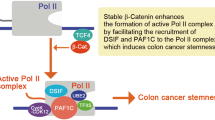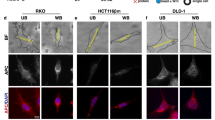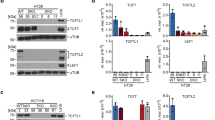Abstract
Mutations in the adenomatous polyposis coli (APC) tumour-suppressor gene occur in most human colon cancers1. Loss of functional APC protein results in the accumulation of β-catenin2. Mutant forms of β-catenin have been discovered in colon cancersthat retain wild-type APC genes3,4, and also in melanomas5, medulloblastomas6, prostate cancer7 and gastric8 and hepatocellular9,10 carcinomas. The accumulation of β-catenin activates genes that are responsive to transcription factors of the TCF/LEF family, with which β-catenin interacts11,12,13,14,15. Here we show that β-catenin activates transcription from the cyclin D1 promoter, and that sequences within the promoter that are related to consensus TCF/LEF-binding sites are necessary for activation. The oncoprotein p21ras further activates transcription of the cyclin D1 gene, through sites within the promoter that bind the transcriptional regulators Ets or CREB. Cells expressing mutant β-catenin produce high levels of cyclin D1 messenger RNA and protein constitutively. Furthermore, expression of a dominant-negative form of TCF in colon-cancer cells strongly inhibits expression of cyclin D1 without affecting expression of cyclin D2, cyclin E, or cyclin-dependent kinases 2, 4 or 6. This dominant-negative TCF causes cells to arrest in the G1 phase of the cell cycle; this phenotype can be rescued by expression of cyclin D1 under the cytomegalovirus promoter. Abnormal levels of β-catenin may therefore contribute to neoplastic transformation by causing accumulation of cyclin D1.
This is a preview of subscription content, access via your institution
Access options
Subscribe to this journal
Receive 51 print issues and online access
$199.00 per year
only $3.90 per issue
Buy this article
- Purchase on SpringerLink
- Instant access to full article PDF
Prices may be subject to local taxes which are calculated during checkout






Similar content being viewed by others
References
Kinzler, K. & Vogelstein, B. Lessons from hereditary colorectal cancer. Cell 87, 159–170 (1996).
Munemitsu, S., Albert, I., Souza, B., Rubinfeld, B. & Polakis, P. Regulation of intracellular β-catenin levels by the adenomatous polyposis coli (APC) tumor-suppressor protein. Proc. Natl Acad. Sci. USA 92, 3046–3050 (1995).
Korinek, V. et al. Constitutive transcriptional activation by a β-catenin-Tcf complex in APC−/− colon carcinoma. Science 275, 1784–1787 (1997).
Morin, P. et al. Activation of β-catenin-Tcf signaling in colon cancer by mutations in β-catenin or APC. Science 275, 1787–1790 (1997).
Rubinfeld, B. et al. Stabilization of β-catenin by genetic defects in melanoma cell lines. Science 275, 1790–1792 (1997).
Zurawel, R., Chiappa, S., Allen, C. & Raffel, C. Sporadic medulloblastomas contain β-catenin mutations. Cancer Res. 58, 896–899 (1998).
Voeller, H., Truica, C. & Gelmann, E. β-catenin mutations in human prostate cancer. Cancer Res. 58, 2520–2523 (1998).
Kawanishi, J. et al. Loss of E-cadherin-dependent cell-cell adhesion due to a mutation of the β-catenin gene in a human cancer cell line, HSC-39. Mol. Cell. Biol. 15, 1175–1181 (1995).
Miyoshi, Y. et al. Activation of the β-catenin gene in primary hepatocellular carcinomas by somatic alterations involving Exon 3. Cancer Res. 58, 2524–2527 (1998).
De La Coste, A. et al. Somatic mutations of the β-catenin gene are frequent in mouse and human hepatocellular carcinomas. Proc. Natl Acad. Sci. USA 95, 8847–8851 (1998).
Molenaar, M. et al. XTcf-3 transcription factor mediates β-catenin-induced axis formation in Xenopus embryos. Cell 86, 391–399 (1996).
Behrens, J. et al. Functional interaction of β-catenin with the transcription factor LEF-1. Nature 382, 638–642 (1996).
Clevers, H. & Grosschedl, R. Transcriptional control of lymphoid development: lessons from gene targeting. Immunol. Today 17, 336–343 (1996).
van de Wetering, M. et al. Armadillo coactivates transcription driven by the product of the Drosophila segment polarity gene dTCF. Cell 88, 789–799 (1997).
Geise, K., Kingsley, C., Kirshner, J. & Grosschedl, R. Assembly and function of a TCR-alpha enhancer complex is dependent on LEF-1-induced DNA bending and multiple protein-protein interactions. Genes Dev. 9, 995–1008 (1995).
Huber, O. et al. Nuclear localization of β-catenin by interaction with transcription factor LEF-1. Mech. Dev. 59, 310 (1996).
van der Heyden, M. et al. Identification of connexin43 as a target for wnt signaling. J. Cell Sci. 111, 1741–1749 (1998).
Riese, J. et al. LEF-1, a nuclear factor coordinating signaling inputs from wingless and decapentaplegic. Cell 88, 777–787 (1997).
Brannon, M., Gomperts, M., Sumoy, L., Moon, R. & Kimelman, D. Aβ-catenin/XTcf-3 complex binds to the siamois promoter to regulate dorsal axis specification in Xenopus. Genes Dev. 11, 2359–2370 (1997).
McKendry, R., Hsu, S., Harland, R. & Grosschedl, R. LEF-1/TCF proteins mediate Wnt-inducible transcription from the Xenopus Nodal related 3 promoter. Dev. Biol. 192, 420–431 (1997).
He, T. et al. Identification of c-myc as a target of the APC pathway. Science 281, 1509–1512 (1998).
Arber, N. et al. Increased expression of cyclin D1 is an early event in multistage colorectal carcinogenesis. Gastroenterology 110, 669–674 (1996).
Arber, N. et al. Antisense to cyclin D1 inhibits the growth and tumorigenicity of human colon cancer cells. Cancer Res. 57, 1569–1574 (1997).
Motokura, T. & Arnold, A. PRAD1/cyclin D1 proto-oncogene: genomic organization, 5′DNA sequence, and sequence of a tumor-specific rearrangement breakpoint. Genes Chromosom. Cancer 7, 89–95 (1993).
Albanese, C. et al. Transforming p21ras mutants and c-ets-2 activate the cyclin D1 promoter through distinguishable regions. J. Biol. Chem. 270, 23589–23597 (1995).
Zhang, T. et al. Concurrent overexpression of cyclin D1 and cyclin-dependent kinase 4 (cdk4) in intestinal adenomas from multiple intestinal neoplasia (Min) mice and human familial adenomatous polyposis patients. Cancer Res. 57, 169–175 (1997).
Quelle, D. et al. Overexpression of mouse D-type cyclins accelerates G1 phase in rodent fibroblasts. Genes Dev. 7, 1559–1571 (1993).
Lahti, J. et al. Elimination of cyclin D1 in vertebrate cells leads to an altered cell cycle phenotype, which is rescued by overexpression of murine cyclins D1, D2, or D3 but not by a mutant cyclin D1. J. Biol. Chem. 272, 10859–10869 (1997).
Acknowledgements
We thank J. Xie, G. Yount, P. Sabbatini and P. Rodriguez-Viciana for technical advice, H. Clevers for suggestions, and other members of the McCormick and Stokoe labs for useful discussions. This work was supported in part by the Daiichi Cancer Research Program.
Author information
Authors and Affiliations
Corresponding author
Rights and permissions
About this article
Cite this article
Tetsu, O., McCormick, F. β-Catenin regulates expression of cyclin D1 in colon carcinoma cells. Nature 398, 422–426 (1999). https://doi.org/10.1038/18884
Received:
Accepted:
Issue Date:
DOI: https://doi.org/10.1038/18884



